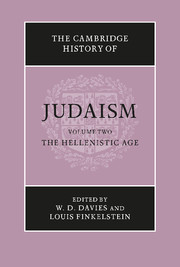Book contents
- Frontmatter
- 1 The archeology of Hellenistic Palestine
- 2 The political and social History of Palestine from Alexander to Antiochus III (333–187 B.C.E.)
- 3 Hebrew, Aramaic and Greek in the Hellenistic age
- 4 The Diaspora in the Hellenistic age
- 5 The interpenetration of Judaism and Hellenism in the pre-Maccabean period
- 6 The men of the Great Synagogue (circa 400–170 .b.c.e.)
- 7 Pharisaic leadership after the Great Synagogue (170 B.C.E.–135 C.E.)
- 8 Antiochus IV
- 9 The Hasmonean revolt and the Hasmonean dynasty
- 10 Jewish literature in Hebrew and Aramaic in the Greek era
- 11 Jewish–Greek literature of the Greek period
- 12 The Apocrypha and Pseudepigrapha of the Hellenistic period
- 13 The book of Daniel
- 14 The matrix of apocalyptic
- 15 The Septuagint and its Hebrew text
- 16 The Targumim
- 17 The Samaritans
- 18 The growth of anti-Judaism or the Greek attitude towards the Jews
- Bibliographies
- Chronological table
- Index
- References
14 - The matrix of apocalyptic
Published online by Cambridge University Press: 28 March 2008
- Frontmatter
- 1 The archeology of Hellenistic Palestine
- 2 The political and social History of Palestine from Alexander to Antiochus III (333–187 B.C.E.)
- 3 Hebrew, Aramaic and Greek in the Hellenistic age
- 4 The Diaspora in the Hellenistic age
- 5 The interpenetration of Judaism and Hellenism in the pre-Maccabean period
- 6 The men of the Great Synagogue (circa 400–170 .b.c.e.)
- 7 Pharisaic leadership after the Great Synagogue (170 B.C.E.–135 C.E.)
- 8 Antiochus IV
- 9 The Hasmonean revolt and the Hasmonean dynasty
- 10 Jewish literature in Hebrew and Aramaic in the Greek era
- 11 Jewish–Greek literature of the Greek period
- 12 The Apocrypha and Pseudepigrapha of the Hellenistic period
- 13 The book of Daniel
- 14 The matrix of apocalyptic
- 15 The Septuagint and its Hebrew text
- 16 The Targumim
- 17 The Samaritans
- 18 The growth of anti-Judaism or the Greek attitude towards the Jews
- Bibliographies
- Chronological table
- Index
- References
Summary
The Jewish writings gathered under the headings ‘apocrypha’ and ‘pseudepigrapha’ are broadly heterogeneous, as indicated by Professor Delcor in chapter 12. This heterogeneity is due in part to the wide diversity of literary genres utilized by the various writers represented in these ancient works. On a deeper level, however, it reflects a social and religious matrix of great complexity, characterized by divergent streams, diverse foreign and domestic influences, and differing responses to those influences. We shall briefly consider the major apocryphal and pseudepigraphical writings of the last centuries b.c.e. with attention to their social and religious setting. And while conceding the great diversity of these works, we shall suggest that they fall into two general categories which reflect opposing tendencies within postexilic Judaism.
Diversity existed within Israelite religion from early times, as seen for example in divisions caused by the introduction of monarchy, the role of the cult, the claims of rival priestly families, the separate kingdoms of Judah and Israel, and the relation of Yahwism to other religions. Over the sweep of the preexilic period, however, a centripetal force was exerted by the concept of a central cult and the ideal of one people in covenant with Yahweh. This force is manifested, for example, by the way in which even northern prophetic traditions were assimilated to a central Temple ideology in the Deuteronomistic history.
This centripetal force was dealt a stunning blow in the events culminating in 587/6: the Temple was destroyed, and nationhood was lost. Not only were the institutions thereby lost which had contributed a unifying quality to Jewish religious experience; more profoundly, the central theologumenon upon which Yahwism was based was threatened: Zion, the mountain elected by Yahweh, had been violated by worshippers of Marduk, which seemed to thow into question the status of Israel's election, and the binding authority of her institutions.
- Type
- Chapter
- Information
- The Cambridge History of Judaism , pp. 524 - 533Publisher: Cambridge University PressPrint publication year: 1990

